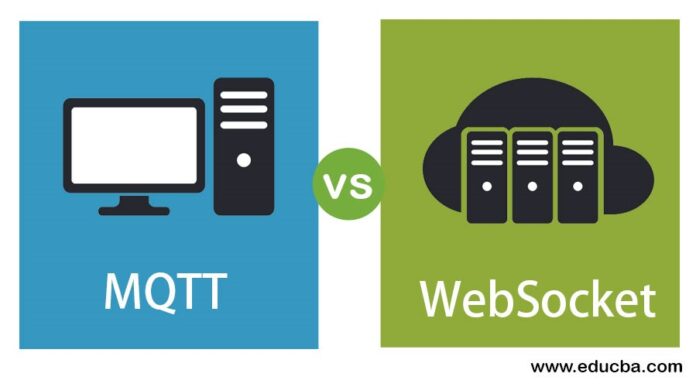Introduction
MQTT is a lightweight publish network protocol that transports messages between devices directly in the web portal. This protocol is absolute for IoT applications like Alexa as they don’t have a web browser to send or receive data. It is suitable for carrying signals and is mainly used for constrained devices with low bandwidth, high latency, or unreliable networks. It also lets you send commands to control action, publish data, and much more.
WebSocket is a computer transmission protocol that creates a two-way channel between a web browser and a server. It passes over a single TCP connection and solves HTTP limitations, enabling low latency bidirectional communication. Using MQTT over a Web socket helps in activating all of MQTT features which are used for many use cases such as:
- Disclosing the live detail
- Allowing the push/alert information
- To examine the current status of devices with the help of retained messages.
- Communicating very quickly with mobile and web applications
Akenza.io
While discussing IoT solutions, akenza.io is the self-service IoT platform providing you to build great IoT products and services with value. It connects, controls, and handles IoT devices in one place.
Akenza.io gives a cloud-based system that connects everyThing to the Cloud.
In the following two time sessions since its evolution, MQTT became the go-to messaging compliance handled by IoT devices. In 2014, Oasis allowed MQTT as an ISO volume, thus marking its universal extension as an IoT messaging compliance. Today, MQTT in IoT aids in connecting millions of devices across numerous businesses under the Azure IoT hub.
Significance of MQTT
MQTT protocol is necessarily a lightweight IoT agreement with considerable significance:
Lightweight and systematic
MQTT protocol asks for a minimal amount of code and consumes notably low power. The MQTT compliance is thus energy-efficient and easy to install for millions of appliances under the Azure IoT hub.
Connecting gadgets during irresponsible networks
MQTT in IoT handles QoS stages to ensure certified information delivery to receivers, even when links between devices are deceptive under the Azure IoT hub.
Allowing communication between the Cloud and appliances
MQTT agreement for IoT establishes the speedy connection between cloud servers and IoT appliances in remote regions.
Last will review
If an IoT device disjoins unexpectedly, the MQTT protocol applies the last will promote to broadcast an active message to other IoT devices in the systems under the Azure IoT hub.
Considerable programming base
MQTT has substantial support in programming expressions such as Python, making it easy for developers to handle under the Azure IoT hub.
Details about MQTT:
Manufacturing
MQTT IoT projects in manufacturing allow vehicle theft protection, vehicle observing, and remote preservation.
Management
One of the top MQTT agreements in the IoT example is in the management sector. MQTT IoT hubs relish Airtel IoT to follow freight vehicles and give real-time perceptions of freight safety and developments under the Azure IoT hub.
Power
IoT MQTT panels in the power sector cooperate to build a more innovative energy framework and optimize consumer power utilization.
Home mechanization
IoT dashboards use MQTT to handle home devices immediately with our phones.
Advantages of MQTT:
The MQTT protocol architecture’s insubstantial properties and minimum overhead support ensure smooth data communication with low bandwidth and reduce the charge on the CPU and RAM.
The contending protocols of MQTT are as under:
- Systematic data communication and quick to execute due to its being a delicate protocol;
- Low network usage due to decreased data packets;
- Frequent distribution of facts;
- Successful execution of remote sensing and power;
- Fast, regular message delivery;
- It uses small amounts of energy, which is applicable for the connected devices; and
- Evaluate network bandwidth.
Difference between MQTT and WebSocket
- MQTT stands for MQ Telemetry transport, the critical protocol for messaging over small appliances. MQTT and WebSockets are two different protocols placed in different layers like TCP and IP.
- But to know the difference between the uses of these protocols, we can clearly say that WebSockets do not issue medium. Still, they are used in an environment to publish architectures.
- Websocket servers can convey messages to clients/groups of clients. They are always open channels for bidirectional data move without appeal for open and close like HTTP.
- While MQTT describes how different machines can talk to each other, they can speak to the same channel. MQTT is a typical subsystem. Publisher machines can issue any message with defined topics on the track, and devices that subscribe to such issues can receive those messages.
- Websockets are specially designed for point connections between a client and a server. However, MQTT adds extra abstraction on top of the primary message-sending mechanism such that multiple attentive machines can accept the topic of their concern.
- Websockets were initially developed for the full-duplex communication channel between browsers and servers. It is used for the connectivity of embedded devices or IoT devices, but it will not be able to influence signals very efficiently. MQTT has been specially considered for IoT devices. Its compose principles are to minimize network bandwidth and give assurance of delivery.

